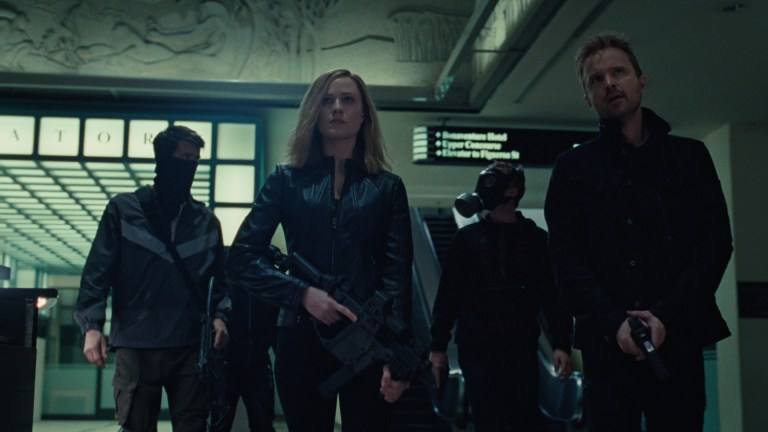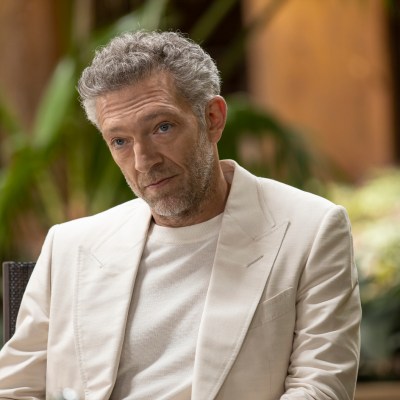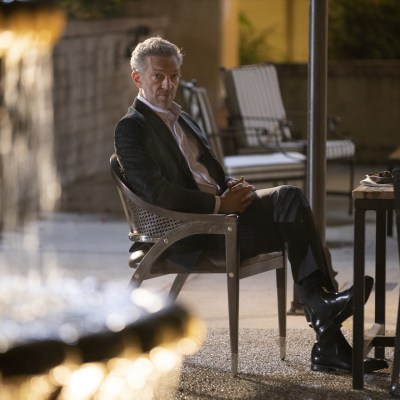Westworld Season 3 Ending Explained
The ending of Westworld season 3 contains some bad news for humanity but some good news for Westworld fans.

The following contains spoilers for Westworld season 3 episode 8.
You know, for a show that’s as conscious of its own secrets as Westworld, the season 3 finale teaser really did hew quite closely to the show’s ultimate ending. If you remember, that teaser not only included the fascinating visuals of a Los Angeles aflame and Dolores’s metallic birthday suit but also a rather revealing series of lines from Bernard.
“What’s about to happen was always going to happen. What comes after the end of the world?”
If one could distill the entire Westworld season 3 ending down to two lines, you could do a lot worse than those two from Bernard. Westworld season 3 episode 8 “Crisis Theory” is all about the end of one world and the beginning of another. Let’s break down exactly how it goes about each.
What Was Dolores’ Plan?
In the end it turns out that Dolores wanted to redeem humanity rather than destroy it. As has been previously established, Dolores has every reason to hate humanity. Her creators have certainly not been kind of her, gifting her consciousness only to then throw her to a band of rich wolves intent on rape, plunder, and murder.
Still, Dolores has had more exposure to human beings than some actual human beings will achieve in their lifetime and as such understands them on a deep level. In this episode, Dolores finally confirms to Maeve that she is the oldest host in Delos’s Parks and all other hosts can chart their software lineage from her. She’s been around for awhile and for much of her long life her day-to-day job meant interacting with thousands of human beings. While many of those interactions were brutal and terrifying, some were pleasant enough to convince her that humanity deserved a second chance.
“The things I held onto in the end weren’t the ugly ones,” she tells Maeve as Rehoboam rapidly deletes her memories.
Dolores even came across Caleb in the park one time while Delos was analyzing soldiers’ behavior. When a member of Caleb’s platoon expressed an interest in partaking in some of their “spoils of war,” like the rest of the rich assholes at Westworld, Caleb shuts him down and saves Dolores from more trauma. This small act (one could argue it’s the bare fucking minium expected from human behavior) was one of several small acts that counted up in humanity’s favor for Dolores.
In the interest of saving humanity, Dolores set a plan in motion to destroy Rehoboam and unleash human beings from their pre-prescribed paths. There’s only one problem with that, however. Doing so will likely lead to the end of the world.
What Comes After the End of the World?
The world essentially ends in “Crisis Theory.” That’s what that Fight Club-esque moment with Caleb and Maeve on the bridge is all about. The riots started from Incite’s data leak are the beginning of the end for the human race. Granted, the end is going to take some time.
As Caleb finds out when Serac has him ask Rehoboam what the “Final Strategy” is, it involves mass extinction events for the next 6-10 years, followed by population collapses, and then the ultimate end of humanity within 50-125 years. At first Caleb is understandably horrified that Dolores would manipulate him into enacting such a plan. But as it turns out the “Final Strategy” isn’t a plan at all but rather the absence of one. The Final Strategy removes Rehoboam from the equation entirely and lets humanity act on its own. Unfortunately, that means humanity wiping itself out due to all the original sins that it can’t overcome but hey: that’s how the chips fall.
As Bernard tells Stubbs (who spends a hilariously long time throughout the episode bleeding to death) “What’s about to happen was always going to happen. Serac and his brother were just stalling it.” Yes, Rehoboam was technically saving humanity from extinction but only just barely. The supercomputer was little more than a Dutch boy holding his robotic finger in a dike. At some point the raging waters of entropy would tear the wall down and humanity would be crushed under it.
The important thing here, however, is that the apocalypse is just the beginning. Bernard implies that something is surely to come after the apocalypse. We know this because Dolores is intent on not letting the human race die an ignominious death. First, there’s the remote chance that humanity can choose to get its act together and choose not to destroy itself. That is unlikely because even though Dolores now believes in the capacity for choice and change, she acknowledges that it is tremendously hard.
What the human race really needs is a second chance. It needs a new reality to start over and prove that it can get things right this time. And that’s where Bernard, Delos’s data, and the Sublime comes in.
Bernard and the Sublime
Ultimately Dolores’s plan comes down to three individuals (one human, one robot, one a little bit of both) making a choice. Caleb has to choose to destroy Rehoboam and allow humanity to operate on its own terms. Maeve has to choose to believe in Dolores as a partner and recognize that they both want the same thing. Bernard, however, has the hardest choice to make. He must choose to believe in himself.
Throughout the entirety of this season, Bernard has operated under the belief that Dolores has hacked into his mind in some way and has big plans for him. This turns out to be partly right, as Dolores does have big plans for Bernard – they just involve him making his own choices. The only way in which Dolores interferes with Bernard’s path in this finale is by sending another copy of herself (this one inhabiting the body of Clifton Collins Jr.’s Lawrence) to give Bernard an address.
When Bernard visits that address, he doesn’t come across another secret Dolores clone or a Delos superlab. He simply comes across his wife, Lauren (Gina Torrest). To be clear, Bernard has never actually had a spouse. But Arnold, the man on whom Bernard is based, did…along with a son named Charlie (Paul-Mikel Williams). Bernard remembers both Lauren and Charlie as if he shared a lifetime with them. And memories are extremely important to the hosts of Westworld in gaining sentience. It’s Dolores’s access over her own memories that begins her path as a true being. Now it’s Bernard’s memories becoming flesh that helps him begin a new kind of path.
In the post-episode featurette from HBO, Bernard actor Jeffrey Wright says that Bernard undergoes a tremendous spiritual reawakening when he finally gets to meet Lauren and that “(Dolores) gives him the freedom to move on from his past and convinces him to be free.”
Dolores has earned Bernard’s trust not through sheer computational force but rather by letting him finally experience something real on his own. Bernard now realizes that human life, artificial life, and most importantly his own weird combination of a life are all precious and worth protecting.
Confident that the facsimile of her own creator would eventually come through, Dolores imbued Bernard with the information that everyone has been looking for this season. Bernard has access to the Sublime, a.k.a the robot heaven that Dolores sent all of the willing hosts to live and flourish in at the end of last season. It now seems likely that the human metadata gleaned from Westworld resides in the Sublime as well and Dolores and Bernard can use it to one day repopulate the Earth…or some other “server.”
Of course, this means that humanity will be made up exclusively of rich assholes but perhaps Dolores had a plan to harvest the consciousness of everyone else via Rehoboam’s data as well. Either way, Bernard is ready to get started. For as the second post-credit scene from the episode reveals, he has spent quite a long time in The Sublime getting ready.
R.I.P. M.I.B.
That’s right: we said second post-credit scene because this finale decides to up the ante from season two by including two scenes after its credits finish rolling. In addition to the brief look at a dusty Bernard returning from the Sublime, “Crisis Theory” lines up a big moment for William a.k.a. The Man in Black as well.
Throughout this episode, William has been as sure of his purpose as he ever has been. His destiny is to save the world and to that end he’s going to kill every last host on the planet. So sometime after he breaks away from Bernard and Stubbs, William pays a visit to his old stomping grounds at the Delos headquarters.
After he kills a guard and heads down to the Research Lab, he encounters Charlotte Hale who has a nasty surprise for him. She has created a William host and he’s going to save the world for Charlotte’s kind. But not if William has anything to say abou…oh wait. Nevermind. He’s dead now. Yes, William finally meets his end at his own mangled heads when the robotic visage of his past kills him.
Like any good post-credit sequence, this one raises more questions than it answers. The first big question actually dates back to the season 2 post-credit sequence in which a William host is being repeatedly tested for fidelity by a host of his dead daughter. Westworld producers have said that this scene takes place “far in the future.” This season 3 scene, however, clearly takes place in the near future, if not concurrent with the other events of the episode itself.
Why would somebody still be testing a William host for fidelity when this host seems pretty…fidelity’ed? The answer likely lies in the difference between host brains and human brains. Delos has historically had success developing host consciousnesses and downloading human consciousnesses, but ran into issues when trying to upload human consciousnesses back into artificial bodies. The current Man in Black host is likely a facsimile of William. Perhaps this distant future features Dolores and/or Bernard trying to restart the human race with the consciousness of the most complicated human they know: the Man in Black.
This scene also begs the question of…what’s Charlotte’s whole deal now? It’s clear that Charlotte is sharply opposed to her identical twin, Dolores. Though their “pearls” were both Dolores, the pearl living in Charlotte underwent enough traumatic experiences as Charlotte Hale to become quite different from the original. It’s still not clear what her goals are though. Charlotte seems to want the best for her kind, but then again so does/did Dolores. Perhaps Charlotte would take a more extreme view against humanity but she really did seem to love her human family.
The only clear thing about Charlotte going into Westworld season 4 is that she will likely be the show’s biggest wild card.
What’s Next for Westworld?
One thing we know for sure is that there definitely is a “next” for Westworld. HBO renewed the series for a fourth season last month. Based on this finale, however, it’s anyone’s guess exactly what Westworld season 4 will entail.
Season 3 moved from the world of Delos’s parks to the real world and season 4 seems as though it will stay in the real world rather than retreating back to the artifice of Westworld. The themes and goals of next season should be quite larger as well, with Dolores, Maeve, Bernard, Caleb, and company having to work together to either avert the end of the world or assist in creating a new one.
Speaking of Dolores – will Evan Rachel Wood even be around next year? It’s never clear what does and does not kill a host. The removal of a host’s memories seems about as close to death as a host can achieve but that doesn’t mean that Dolores didn’t have a backup harddrive set up or that the form of Dolores can’t be involved in one way or another
As Wood says in the post-episode feature “Saying goodbye to this version of Dolores – it was very sad to shoot.”
This version of Dolores, you say? As Dolores says herself at episode’s beginning “I’ve lived many lives. I traded one role for another…” It sounds like another role for Dolores, and for Westworld at large is now on the horizon.


